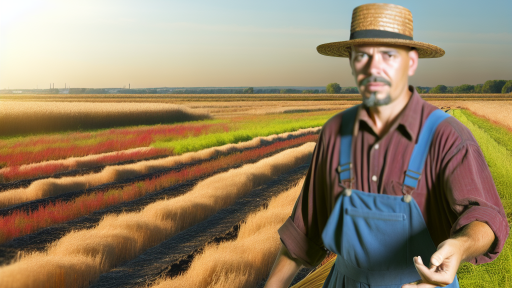Introduction to Cover Cropping and Its Role in Weed Management
Cover cropping offers an effective strategy for reducing weed growth.
This practice involves planting specific crops to enhance soil health.
Additionally, cover crops compete with weeds for resources.
They provide shade, thereby inhibiting weed seed germination.
Moreover, these crops can outgrow weeds, limiting their spread.
Farmers embrace cover crops to create a more sustainable farming system.
Various types of cover crops exist, including legumes and grasses.
Legumes fix nitrogen, enriching the soil for subsequent crops.
Grasses, on the other hand, can form a dense mat to suppress weeds.
The timing of cover crop planting is crucial for effective weed management.
Farmers should plant cover crops before weeds emerge in spring.
Incorporating cover crops into rotation helps maintain soil structure.
This practice enhances moisture retention and nutrients availability.
Furthermore, cover cropping reduces erosion by protecting the soil surface.
Farmers can also benefit from improved biodiversity in their fields.
Transform Your Agribusiness
Unlock your farm's potential with expert advice tailored to your needs. Get actionable steps that drive real results.
Get StartedThis biodiversity can attract beneficial insects and pollinators.
As a result, overall crop health improves, leading to higher yields.
Incorporating cover cropping into agricultural practices requires planning.
Farmers should assess their specific conditions and goals.
Each farm’s needs will dictate which cover crop species to use.
Successful implementation of cover crops requires ongoing management.
Regular evaluation will help farmers adapt and refine their strategies.
Benefits of Using Cover Crops for Weed Suppression
Effective Weed Competition
Cover crops create a dense canopy that outcompetes weeds for resources.
This reduces the sunlight available for weed germination.
Additionally, cover crops absorb nutrients, limiting access for weeds.
As a result, fewer weeds can establish in the soil.
Soil Health Improvement
Cover crops contribute to enhanced soil structure and health.
Their root systems help with soil aeration and water infiltration.
Healthy soil supports beneficial microorganisms that help suppress weeds.
Furthermore, organic matter from decaying cover crops improves nutrient levels.
Pest Management
Some cover crops can deter pests that affect weed survival.
Cover crops can attract beneficial insects, which prey on weed pests.
This natural pest control reduces the reliance on chemical herbicides.
Cost-Effectiveness
Utilizing cover crops can lower overall weed management costs.
By reducing herbicide expenses, farmers can save money over time.
Moreover, enhanced soil health can lead to increased crop yields.
Long-term investment in cover cropping pays off through sustainability.
Enhanced Biodiversity
Cover crops promote a more diverse agricultural environment.
This diversity can lead to a more resilient ecosystem.
Showcase Your Farming Business
Publish your professional farming services profile on our blog for a one-time fee of $200 and reach a dedicated audience of farmers and agribusiness owners.
Publish Your ProfileA robust ecosystem is better able to suppress weed populations naturally.
Thus, cover cropping improves both crop productivity and ecological health.
Types of Cover Crops Effective in Weed Control
Legumes
Legumes are excellent cover crops for suppressing weeds.
They fix nitrogen in the soil, improving fertility.
Examples include clover, vetch, and hairy vetch.
These crops grow rapidly and outcompete weeds.
Additionally, their deep roots enhance soil structure.
Grasses
Grasses provide dense ground cover, limiting weed growth.
Popular choices are rye, oats, and sorghum-sudangrass.
These species grow vigorously, shading out weeds effectively.
Their fibrous root systems help with soil erosion control.
Grasses also improve soil health through organic matter buildup.
Brassicas
Brassicas have unique properties for weed suppression.
They produce allelopathic compounds inhibiting weed seed germination.
Examples include mustards and radishes.
These crops can thrive in poor soils, promoting better growth.
Additionally, they aid in breaking up compacted soil layers.
Multispecies Cover Crops
Using a mixture of cover crops maximizes benefits.
Combining legumes, grasses, and brassicas enhances biodiversity.
This diversity leads to more effective weed suppression strategies.
Furthermore, multispecies crops improve soil health and resilience.
Growers can tailor mixes to specific farm conditions and goals.
See Related Content: How Cover Crops Boost Water Retention in Soil
Methods for Implementing Cover Cropping in Various Agricultural Systems
Understanding Cover Cropping
Cover cropping is a strategic farming practice.
This technique involves planting crops to protect and enrich the soil.
Farmers employ cover crops primarily to suppress weeds.
These crops enhance soil health and improve moisture retention.
Choosing the Right Cover Crops
Select appropriate cover crops based on your region.
Consider the climate, soil type, and main crops grown.
For example, clover and vetch fix nitrogen in the soil.
Additionally, rye and oats prevent erosion and suppress weeds.
Integrating Cover Crops into Crop Rotation
Incorporate cover crops into your crop rotation system.
This approach reduces weed pressure over time.
Rotate cover crops with cash crops to disrupt pest cycles.
Furthermore, varying root structures improves soil structure.
Timing of Planting and Termination
Timing is crucial for successful cover cropping.
Plant cover crops at the end of the growing season.
Terminate them before planting the main crop.
This practice maximizes their benefits while minimizing competition.
Cover Crop Management Techniques
Proper management is key to effective cover cropping.
Showcase Your Farming Business
Publish your professional farming services profile on our blog for a one-time fee of $200 and reach a dedicated audience of farmers and agribusiness owners.
Publish Your ProfileUse a variety of methods to establish and manage cover crops.
- Drilling seeds can enhance planting efficiency.
- Broadcasting followed by rolling or packing promotes better soil contact.
- Incorporating cover crops into soil can enhance nutrient cycling.
Evaluating the Impact
Regularly assess the effectiveness of cover cropping practices.
Evaluate weed suppression, soil health, and overall yields.
This evaluation helps refine future cover cropping strategies.
Additionally, gather data to support sustainable farming methods.
You Might Also Like: Smart Farming Solutions For Crop Monitoring Needs
Integrating Cover Crops with Crop Rotation to Maximize Weed Reduction
Understanding Cover Cropping
Cover cropping involves planting specific crops to improve soil health.
These crops protect the soil from erosion and suppress weed growth.
By using diverse plant species, farmers can discourage weed establishment.
This practice enhances the soil’s nutrient profile and structure.
Benefits of Crop Rotation
Crop rotation involves changing the type of crop grown in a specific area each season.
This method disrupts pest and weed life cycles effectively.
Rotating crops improves soil fertility and reduces disease pressure.
Farmers can strategically plan rotations to include cover crops.
Optimizing Weed Suppression
Combining cover crops with crop rotation maximizes weed suppression.
Diverse cover crops can outcompete weeds for light and nutrients.
For instance, mixing legumes with grasses provides a robust ground cover.
This strategy creates a barrier that hinders weed germination.
Implementing Effective Strategies
Farmers should choose cover crops based on their specific soil and climate conditions.
Winter rye and crimson clover are popular choices for cold climates.
In warmer areas, sun hemp and buckwheat can thrive.
Planning the timing of sowing and termination of cover crops is essential.
Monitoring and Adjusting Practices
Continuous monitoring of weed levels is crucial for success.
Farmers should adjust their cover crops and rotation plans as needed.
Over time, they will discover what combinations work best for their fields.
This adaptive management approach enhances long-term sustainability.
Find Out More: Cover Crop Termination Methods for Best Results

Timing and Management Practices for Effective Cover Crop Establishment
Understanding the Importance of Timing
Timing plays a crucial role in cover crop success.
Planting at the right time can enhance biomass production.
Moreover, it helps in suppressing weeds effectively.
In general, cover crops should be sown after harvesting the main crop.
This practice maximizes soil coverage during fallow periods.
Choosing the Right Crop
Selecting an appropriate cover crop species is vital.
Diversity in cover crops can enhance benefits.
For instance, legumes fix nitrogen in the soil.
Additionally, cereals can compete well with weeds.
Consult local agronomists for species recommendations.
Ssoil Preparation and Planting Techniques
Proper soil preparation is necessary for successful establishment.
Remove crop residues to minimize disease risk.
Use a seedbed preparation method that suits your soil type.
Showcase Your Farming Business
Publish your professional farming services profile on our blog for a one-time fee of $200 and reach a dedicated audience of farmers and agribusiness owners.
Publish Your ProfileLegume inoculation may increase nitrogen fixation efficiency.
Ensure proper planting depth for optimal germination.
Maintenance Considerations
Regular monitoring of cover crops is essential.
Check for adequate moisture levels, especially in dry periods.
Infestations of pests or diseases should be addressed promptly.
Termination Timing and Methods
Timing for terminating cover crops is equally important.
Termination should occur before the primary crop planting.
Various methods, such as mowing and herbicide application, can be effective.
Ensure no significant residues remain that could suppress cash crop growth.
Benefits of Proper Management Practices
Adopting effective management practices leads to multiple benefits.
It promotes soil health and fertility over time.
Furthermore, it can significantly reduce weed pressure.
In the long term, these strategies boost overall crop yields.
See Related Content: Choosing the Right Hydroponic Setup
Case Studies and Success Stories: Cover Cropping in Action
Introduction to Successful Cover Cropping
Cover cropping has proven effective in reducing weeds.
This strategy enhances soil health and supports biodiversity.
In many case studies, farmers report significant reductions in weed populations.
Successful Implementation by Green Meadows Farm
Green Meadows Farm adopted cover cropping three years ago.
They planted winter rye and crimson clover during off-seasons.
As a result, weed growth decreased by over 70 percent each year.
This transition also improved soil structure and moisture retention.
A Fruit Orchard’s Transformation at Sunny Orchard Farms
They implemented a cover crop strategy using vetch and radishes.
This practice effectively suppressed summer annual weeds.
The orchard saw a marked improvement in fruit quality and yield.
Innovative Techniques at River Valley Ranch
River Valley Ranch experimented with diverse cover crops.
They used a mix of legumes and grasses to maximize ground cover.
This practice not only outcompeted weeds but also enhanced biodiversity.
Farmers reported increased pollinator activity and healthier ecosystems.
Community Success: Workshops and Knowledge Sharing
Many farmers benefit from community-focused workshops.
These workshops teach effective cover cropping techniques.
Participants discuss successes and share practical tips on implementation.
This collaborative effort fosters a spirit of innovation and sustainability.
Long-Term Benefits Observed
Farmers using cover cropping report lasting improvements.
The persistent reduction in weeds lowers herbicide reliance.
Additionally, soil fertility benefits from enhanced organic matter.
Long-term, these methods lead to more sustainable farming practices.
Challenges and Considerations in Cover Cropping for Weed Management
Understanding Cover Cropping
Cover cropping involves planting specific crops to manage soil health.
Farmers often choose cover crops based on their unique benefits.
These can include suppressing weeds and enhancing soil fertility.
Showcase Your Farming Business
Publish your professional farming services profile on our blog for a one-time fee of $200 and reach a dedicated audience of farmers and agribusiness owners.
Publish Your ProfileIdentifying Weed Pressure
Weed pressure varies greatly among locations and seasons.
Farmers need to assess specific weed types in their fields.
Understanding the life cycle of these weeds aids in choosing appropriate cover crops.
Choosing the Right Cover Crops
Not all cover crops effectively suppress weeds.
Farmers should select species known for their competitive abilities.
Examples include ryegrass, clover, and vetch.
Each of these crops provides different benefits when integrated into farming systems.
Proper Timing of Planting and Termination
Timing is crucial for successful weed suppression.
Farmers must plant cover crops early enough in the season.
Additionally, timely termination of cover crops is essential to prevent weeds.
Delays in termination can result in competition for moisture and nutrients.
Managing Soil Health and Fertility
Cover crops influence soil health, impacting weed management.
Healthy soils promote vigorous crop growth, outcompeting weeds.
Farmers should regularly test soil to monitor fertility levels.
This assessment aids in making informed decisions about cover crops.
Financial and Resource Considerations
Implementing cover cropping can require significant investment.
Farmers should evaluate costs and potential returns on investment.
Utilizing cover crops can lead to reduced herbicide reliance in the long term.
Efficient planning often helps mitigate upfront costs.
Potential Challenges with Pests and Diseases
Cover crops may attract pests or diseases in some situations.
Farmers should monitor crops closely for signs of trouble.
Maintaining diverse cover crops can also help reduce these risks.
Educating and Collaborating with the Community
Farmers can benefit by sharing experiences and strategies.
Workshops and local farming groups provide valuable resources.
Participation in these communities enhances knowledge and reduces challenges.
Additional Resources
Managing Pests with Cover Crops – SARE
Cover Cropping to Improve Climate Resilience | USDA Climate Hubs




